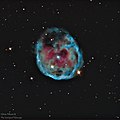|
NGC 246
NGC 246 (also known as the Skull Nebula[5] or Caldwell 56) is a planetary nebula in the constellation Cetus. It was discovered in 1785 by William Herschel. The nebula and the stars associated with it are listed in several catalogs, as summarized by the SIMBAD database.[1] The nebula is roughly 3,500+720 NGC 246 is not to be confused with the Rosette Nebula (NGC 2337), which is also referred to as the "Skull."[10] Among some amateur astronomers, NGC 246 is known as the "Pac-Man Nebula" because of the arrangement of its central stars and the surrounding star field.[6] Image gallery
References
External links
|
||||||||||||||||||||||||||||


